Genetic Parameter Estimates for Growth of Hāpuku (Groper, Polyprion oxygeneios) in Land-Based Aquaculture Using Random Regression Models
Abstract
:1. Introduction
2. Materials and Methods
2.1. Experimental Population and Rearing Conditions
2.2. Data Collection
2.3. Genotyping and Parentage Assignment
2.4. Data Quality Control and Editing
2.5. Model Development and Genetic Parameter Estimation
3. Results and Discussion
3.1. Mating Success and Parental Contributions
3.2. Phenotypic Data
3.3. Genetic Model Selection
3.4. Genetic Parameter Estimates
3.5. Synthesis and Prospectus
4. Conclusions
Supplementary Materials
Author Contributions
Funding
Institutional Review Board Statement
Data Availability Statement
Acknowledgments
Conflicts of Interest
References
- Nelson, J.S. Fishes of the World, 3rd ed.; John Wiley & Sons, Inc.: New York, NY, USA, 1994; 600p. [Google Scholar]
- Paxton, J.R.; Hoese, D.F.; Allen, G.R.; Hanley, J.E. Pisces Petromyzontidae to Carangidae; Zoological Catalogue of Australia; Australian Biological Resources Survey: Canberra, Australia, 1989. [Google Scholar]
- Milessi, A.C.; Wysiecki, A.M.D.; Carvalho Filho, A.; Wiff, R. First report of the hapuku wreckfish Polyprion oxygeneios (Polyprionidae) in Argentinian waters. Lat. Am. J. Aquat. Res. 2021, 49, 354–358. [Google Scholar] [CrossRef]
- Francis, M.; Mulligan, K.; Davies, N.; Beentjes, M. Age and growth estimates for New Zealand hāpuku, Polyprion oxygeneios. Fish. Bull. 1999, 97, 227–242. [Google Scholar]
- Barreiros, J.P.; Machado, L.; Hostim-Silva, M.; Sazima, I.; Heemstra, P.C. First record of Polyprion oxygeneios (Perciformes: Polyprionidae) for the south-west Atlantic and a northernmost range extension. J. Fish Biol. 2004, 64, 1439–1441. [Google Scholar] [CrossRef]
- Wakefield, C.B.; Newman, S.J.; Molony, B.W. Age-based demography and reproduction of hāpuku, Polyprion oxygeneios, from the south coast of Western Australia: Implications for management. ICES J. Mar. Sci. 2010, 67, 1164–1174. [Google Scholar] [CrossRef]
- Johnston, A. The southern Cook Strait groper fishery [Polyprion oxygeneios, New Zealand]. In Fisheries Technica Report; New Zealand Ministry of Agriculture and Fisheries: Wellington, New Zealand, 1983. [Google Scholar]
- Symonds, J.; Walker, S.; Pether, S.; Gublin, Y.; McQueen, D.; King, A.; Irvine, G.; Setiawan, A.; Forsythe, J.; Bruce, M. Developing yellowtail kingfish (Seriola lalandi) and hāpuku (Polyprion oxygeneios) for New Zealand aquaculture. N. Z. J. Mar. Freshw. Res. 2014, 48, 371–384. [Google Scholar] [CrossRef]
- Fisheries New Zealand. Fisheries Infosite. Available online: https://fs.fish.govt.nz/Page.aspx?pk=7&sc=HPB&ey=0 (accessed on 10 June 2024).
- Paul, L. A Description of the New Zealand Fisheries for the Two Groper Species, Hapuku (Polyprion oxygenezbs) and Bass (P. ameficanza); Ministry of Fisherie: Wellington, New Zealand, 2002.
- Papageorgiou, P. Marketing development for new Mediterranean aquaculture species: Enterprise strategies. Cah. Options Mediterr 1999, 47, 11–24. [Google Scholar]
- Mylonas, C.; Robles, R. DIVERSIFY: Enhancing the European aquaculture production by removing production bottlenecks of emerging species, producing new products and accessing new markets. Aquac. Eur. 2014, 39, 5–15. [Google Scholar]
- Quéméner, L.; Suquet, M.; Mero, D.; Gaignon, J.-L. Selection method of new candidates for finfish aquaculture: The case of the French Atlantic, the Channel and the North Sea coasts. Aquat. Living Resour. 2002, 15, 293–302. [Google Scholar] [CrossRef]
- Heasman, K.G.; Scott, N.; Ericson, J.A.; Taylor, D.I.; Buck, B.H. Extending New Zealand’s Marine Shellfish Aquaculture Into Exposed Environments—Adapting to Modern Anthropogenic Challenges. Front. Mar. Sci. 2020, 7, 565686. [Google Scholar] [CrossRef]
- Chavanne, H.; Janssen, K.; Hofherr, J.; Contini, F.; Haffray, P.; Consortium, A.; Komen, H.; Nielsen, E.E.; Bargelloni, L. A comprehensive survey on selective breeding programs and seed market in the European aquaculture fish industry. Aquac. Int. 2016, 24, 1287–1307. [Google Scholar] [CrossRef]
- Besson, M.; Allal, F.; Chatain, B.; Vergnet, A.; Clota, F.; Vandeputte, M. Combining individual phenotypes of feed intake with genomic data to improve feed efficiency in sea bass. Front. Genet. 2019, 10, 219. [Google Scholar] [CrossRef] [PubMed]
- Besson, M.; Komen, H.; Rose, G.; Vandeputte, M. The genetic correlation between feed conversion ratio and growth rate affects the design of a breeding program for more sustainable fish production. Genet. Sel. Evol. 2020, 52, 5. [Google Scholar] [CrossRef] [PubMed]
- Thodesen, J.; Grisdale-Helland, B.; Helland, S.J.; Gjerde, B. Feed intake, growth and feed utilization of offspring from wild and selected Atlantic salmon (Salmo salar). Aquaculture 1999, 180, 237–246. [Google Scholar] [CrossRef]
- Kause, A.; Tobin, D.; Houlihan, D.; Martin, S.; Mantysaari, E.; Ritola, O.; Ruohonen, K. Feed efficiency of rainbow trout can be improved through selection: Different genetic potential on alternative diets. J. Anim. Sci. 2006, 84, 807–817. [Google Scholar] [CrossRef] [PubMed]
- Ogata, H.Y.; Oku, H.; Murai, T. Growth, feed efficiency and feed intake of offspring from selected and wild Japanese flounder (Paralichthys olivaceus). Aquaculture 2002, 211, 183–193. [Google Scholar] [CrossRef]
- Dunnington, E.A.; Siegel, P.B. Long-Term Divergent Selection for Eight-Week Body Weight in White Plymouth Rock Chickens. Poult. Sci. 1996, 75, 1168–1179. [Google Scholar] [CrossRef]
- Sanchez, M.-P.; Chevassus, B.; Labbé, L.; Quillet, E.; Mambrini, M. Selection for growth of brown trout (Salmo trutta) affects feed intake but not feed efficiency. Aquat. Living Resour. 2001, 14, 41–48. [Google Scholar] [CrossRef]
- Yang, Y.; Li, R.; Li, S. An estimation method for genetic parameters of dynamic traits. Acta Vet. Et Zootech. Sin. 1996, 27, 412–416. [Google Scholar]
- Kirkpatrick, M.; Lofsvold, D.; Bulmer, M. Analysis of the inheritance, selection and evolution of growth trajectories. Genetics 1990, 124, 979–993. [Google Scholar] [CrossRef]
- Schaeffer, L.R. Application of random regression models in animal breeding. Livest. Prod. Sci. 2004, 86, 35–45. [Google Scholar] [CrossRef]
- Meyer, K. Scope for a random regression model in genetic evaluation of beef cattle for growth. Livest. Prod. Sci. 2004, 86, 69–83. [Google Scholar] [CrossRef]
- He, J.; Zhao, Y.; Zhao, J.; Gao, J.; Han, D.; Xu, P.; Yang, R. Multivariate random regression analysis for body weight and main morphological traits in genetically improved farmed tilapia (Oreochromis niloticus). Genet. Sel. Evol. 2017, 49, 80. [Google Scholar] [CrossRef]
- Rutten, M.J.M.; Komen, H.; Bovenhuis, H. Longitudinal genetic analysis of Nile tilapia (Oreochromis niloticus L.) body weight using a random regression model. Aquaculture 2005, 246, 101–113. [Google Scholar] [CrossRef]
- Turra, E.M.; de Oliveira, D.A.A.; Valente, B.D.; Teixeira, E.d.A.; Prado, S.d.A.; de Melo, D.C.; Fernandes, A.F.A.; de Alvarenga, É.R.; e Silva, M.d.A. Estimation of genetic parameters for body weights of Nile tilapia Oreochromis niloticus using random regression models. Aquaculture 2012, 354–355, 31–37. [Google Scholar] [CrossRef]
- Campideli, T.S.; Leite, N.R.; Moreira, R.L.; Abreu, L.R.A.; Campos, F.G.; Fernandes, A.F.A.; Turra, E.M.; Pedreira, M.M.; Silva, M.A.; Bonafé, C.M. Genetic sensitivity of Chitralada Nile Tilapia (Oreochromis niloticus) body weight to dietetic lysine levels. Aquaculture 2020, 528, 735530. [Google Scholar] [CrossRef]
- Fernandes, A.F.A.; Alvarenga, É.R.; Alves, G.F.O.; Manduca, L.G.; Toral, F.L.B.; Valente, B.D.; Silva, M.A.; Rosa, G.J.M.; Turra, E.M. Genotype by environment interaction across time for Nile tilapia, from juvenile to finishing stages, reared in different production systems. Aquaculture 2019, 513, 734429. [Google Scholar] [CrossRef]
- Conti, A.C.M.; Oliveira, C.A.L.d.; Martins, E.N.; Ribeiro, R.P.; Bignardi, A.B.; Porto, E.P.; Oliveira, S.N.d. Genetic parameters for weight gain and body measurements for Nile tilapias by random regression modeling. Semin. Ciências Agrárias 2014, 35, 2843–2858. [Google Scholar] [CrossRef]
- Maldonado Turra, E.; Aparecida Andrade de Oliveira, D.; Dourado Valente, B.; de Alencar Teixeira, E.; de Assis Prado, S.; Ramos de Alvarenga, É.; Chemim de Melo, D.; Silva Felipe, V.P.; Araújo Fernandes, A.F.; de Almeida e Silva, M. Longitudinal genetic analyses of fillet traits in Nile tilapia Oreochromis niloticus. Aquaculture 2012, 356–357, 381–390. [Google Scholar] [CrossRef]
- Wang, B.; Gu, W.; Gao, H.; Hu, G.; Yang, R. Longitudinal genetic analysis for growth traits in the complete diallel cross of rainbow trout (Oncorhynchus mykiss). Aquaculture 2014, 430, 173–178. [Google Scholar] [CrossRef]
- Mckay, L.R.; Schaeffer, L.R.; Mcmillan, I. Analysis of growth curves in Rainbow Trout using random regression. In Proceedings of the Proceedings of the World Congress on Genetics Applied to Livestock Production, Montpellier, France, 19–23 August 2002. [Google Scholar]
- Zhao, J.; Zhao, Y.; Song, Z.; Liu, H.; Liu, Y.; Yang, R. Genetic analysis of the main growth traits using random regression models in Japanese flounder (Paralichthys olivaceus). Aquac. Res. 2018, 49, 1504–1511. [Google Scholar] [CrossRef]
- Yang, L.a.; Wang, L.; Wu, Z.; Hao, Z.; Song, Z.; You, F.; Yang, R. Genetic effects of ibreeding on growth trajectories in turbot (Scophthalmus maximus). Aquaculture 2021, 536, 736470. [Google Scholar] [CrossRef]
- Yu, X.; Bastiaansen, J.W.M.; Gulzari, B.; Camara, M.; Mulder, H.A.; Komen, H.; Groenen, M.A.M.; Megens, H.-J. Genome-wide association analyses reveal genotype-by-environment interactions of growth and organ weights in gilthead seabream (Sparus aurata). Aquaculture 2024, 589, 740984. [Google Scholar] [CrossRef]
- Symonds, J.; Walker, S.; Ven, I.; Marchant, A.; Irvine, G.; Pether, S.; Gublin, Y.; Bruce, M.; Anderson, R.; McEwan, K. Developing broodstock resources for farmed marine fish. Proc. N. Z. Soc. Anim. Prod. 2012, 7, 222–226. [Google Scholar]
- Palmer, P.J.; Burke, M.J.; Palmer, C.J.; Burke, J.B. Developments in controlled green-water larval culture technologies for estuarine fishes in Queensland, Australia and elsewhere. Aquaculture 2007, 272, 1–21. [Google Scholar] [CrossRef]
- Papandroulakis, N.; Divanach, P.; Anastasiadis, P.; Kentouri, M. The pseudo-green water technique for intensive rearing of sea bream (Sparus aurata) larvae. Aquac. Int. 2001, 9, 205–216. [Google Scholar] [CrossRef]
- Alves, D.; Specker, J.L.; Bengtson, D.A. Investigations into the causes of early larval mortality in cultured summer flounder (Paralichthys dentatus L.). Aquaculture 1999, 176, 155–172. [Google Scholar] [CrossRef]
- Eda, H.; Murashige, R.; Oozeki, Y.; Hagiwara, A.; Eastham, B.; Bass, P.; Tamaru, C.S.; Lee, C.-S. Factors affecting intensive larval rearing of striped mullet, Mugil cephalus. Aquaculture 1990, 91, 281–294. [Google Scholar] [CrossRef]
- R Core Team. R: A Language and Environment for Statistical Computing; R Foundation for Statistical Computing: Vienna, Austria, 2024. [Google Scholar]
- Wylie, M.J.; Setiawan, A.N.; Irvine, G.W.; Elizur, A.; Zohar, Y.; Symonds, J.E.; Lokman, P.M. Induced spawning of F1 wreckfish (Hāpuku) Polyprion oxygeneios using a synthetic sgonist of gonadotropin-releasing hormone. Fishes 2019, 4, 41. [Google Scholar] [CrossRef]
- Wylie, M.J.; Setiawan, A.N.; Irvine, G.W.; Symonds, J.E.; Elizur, A.; Dos Santos, M.; Lokman, P.M. Ovarian development of captive F1 wreckfish (hāpuku) Polyprion oxygeneios under constant and varying temperature regimes—Implications for broodstock management. Gen. Comp. Endocrinol. 2018, 257, 86–96. [Google Scholar] [CrossRef]
- Butler, D.G.; Cullis, B.R.; Gilmour, A.R.; Gogel, B.G.; Thompson, R. ASReml-R Reference Manual Version 4.2; VSN International Ltd.: Hemel Hempstead, UK, 2023. [Google Scholar]
- Verbyla, A.P. A note on model selection using information criteria for general linear models estimated using REML. Aust. N. Z. J. Stat. 2019, 61, 39–50. [Google Scholar] [CrossRef]
- Gengler, N.; Tijani, A.; Wiggans, G.R.; Misztal, I. Estimation of (co)variance function coefficients for test day yield with a expectation-maximization restricted maximum likelihood algorithm. J. Dairy Sci. 1999, 82, 1849.e1–1849.e23. [Google Scholar] [CrossRef]
- Mrode, R.A. Linear Models for the Prediction of Animal Breeding Values; CABI: Wallingford, UK, 2014. [Google Scholar]
- Meyer, K.; Hill, W.G. Estimation of genetic and phenotypic covariance functions for longitudinal or ‘repeated’records by restricted maximum likelihood. Livest. Prod. Sci. 1997, 47, 185–200. [Google Scholar] [CrossRef]
- Houston, R.D.; Bean, T.P.; Macqueen, D.J.; Gundappa, M.K.; Jin, Y.H.; Jenkins, T.L.; Selly, S.L.C.; Martin, S.A.M.; Stevens, J.R.; Santos, E.M.; et al. Harnessing genomics to fast-track genetic improvement in aquaculture. Nat. Rev. Genet. 2020, 21, 389–409. [Google Scholar] [CrossRef]
- Hinrichs, D.; Wetten, M.; Meuwissen, T.H.E. An algorithm to compute optimal genetic contributions in selection programs with large numbers of candidates. J. Anim Sci. 2006, 84, 3212–3218. [Google Scholar] [CrossRef]
- Meuwissen, T.H. Maximizing the response of selection with a predefined rate of inbreeding. J. Anim. Sci. 1997, 75, 934–940. [Google Scholar] [CrossRef]
- Meuwissen, T.H.E.; Sonesson, A.K. Maximizing the response of selection with a predefined rate of inbreeding: Overlapping generations. J. Anim. Sci. 1998, 76, 2575–2583. [Google Scholar] [CrossRef]
- Tuckey, N.P.L.; Ashton, D.T.; Li, J.; Lin, H.T.; Walker, S.P.; Symonds, J.E.; Wellenreuther, M. Automated image analysis as a tool to measure individualised growth and population structure in Chinook salmon (Oncorhynchus tshawytscha). Aquac. Fish Fish. 2022, 2, 402–413. [Google Scholar] [CrossRef]
- Vallecillos, A.; María-Dolores, E.; Villa, J.; Afonso, J.M.; Armero, E. Potential use of image analysis in breeding programs for growth and yield traits in meagre (Argyrosomus regius). J. Mar. Sci. Eng. 2023, 11, 2067. [Google Scholar] [CrossRef]
- Gulzari, B.; Mencarelli, A.; Roozeboom, C.; Komen, H.; Bastiaansen, J.W.M. Prediction of production traits by using body features of gilthead seabream (Sparus aurata) obtained from digital images. In Proceedings of the 12th World Congress on Genetics Applied to Livestock Production (WCGALP) 2412, Rotterdam, The Netherlands, 3–8 August 2022. [Google Scholar] [CrossRef]
- Gulzari, B. All Fish Deserve a Breeding Program: Designing Affordable Genomic Selection Programs with Automated Image Analysis. Ph.D. Thesis, Wageningen University, Wageningen, The Netherlands, 2023. [Google Scholar]
- Hasan, M.M.; Thomson, P.C.; Raadsma, H.W.; Khatkar, M.S. Genetic analysis of digital image derived morphometric traits of black tiger shrimp (Penaeus monodon) by incorporating G × E investigations. Front. Genet. 2022, 13, 1007123. [Google Scholar] [CrossRef]
- Liao, Y.H.; Zhou, C.W.; Liu, W.Z.; Jin, J.Y.; Li, D.Y.; Liu, F.; Fan, D.D.; Zou, Y.; Mu, Z.B.; Shen, J.; et al. 3DPhenoFish: Application for two- and three-dimensional fish morphological phenotype extraction from point cloud analysis. Zool. Res. 2021, 42, 492–501. [Google Scholar] [CrossRef]
- Gutzmann, S.B.; Hodgson, E.E.; Braun, D.; Moore, J.W.; Hovel, R.A. Predicting fish weight using photographic image analysis: A case study of broad whitefish in the lower Mackenzie River watershed. Arct. Sci. 2022, 8, 1356–1361. [Google Scholar] [CrossRef]
- Cisar, P.; Bekkozhayeva, D.; Movchan, O.; Saberioon, M.; Schraml, R. Computer vision based individual fish identification using skin dot pattern. Sci. Rep. 2021, 11, 16904. [Google Scholar] [CrossRef]
- Pauzi, S.; Hassan, M.; Yusoff, N.; Harun, N.; Bakar, A.A.; Kua, B. A review on image processing for fish disease detection. In Journal of Physics: Conference Series; IOP Publishing: Bristol, UK, 2021; p. 012042. [Google Scholar]
- Mackvandi, B.B.; Borghei, A.M.; Javadi, A.; Minaei, S.; Almassi, M. Determination of biometric parameters of fish by image analysis. J. Bio. Environ. Sci. 2015, 6, 272–276. [Google Scholar]

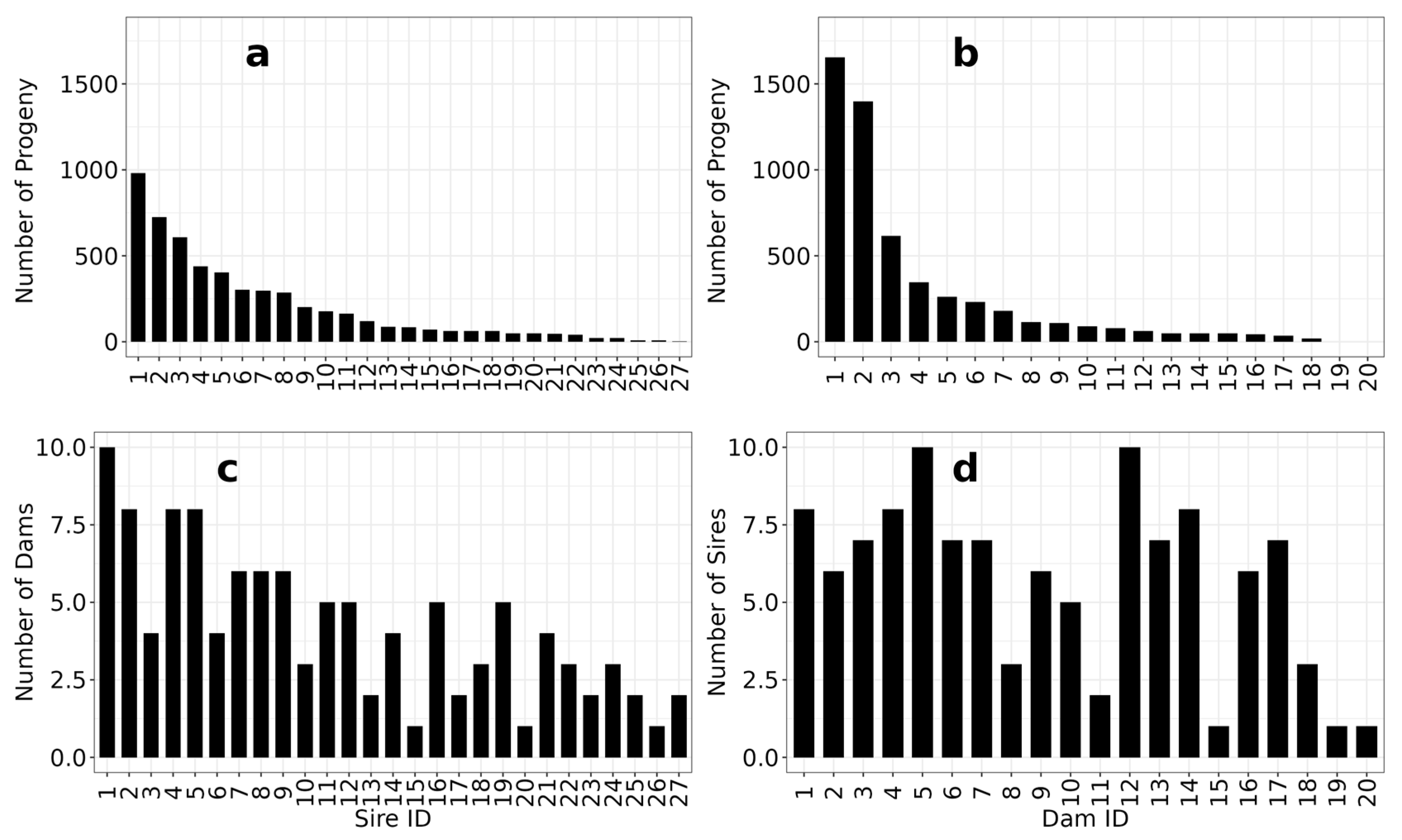

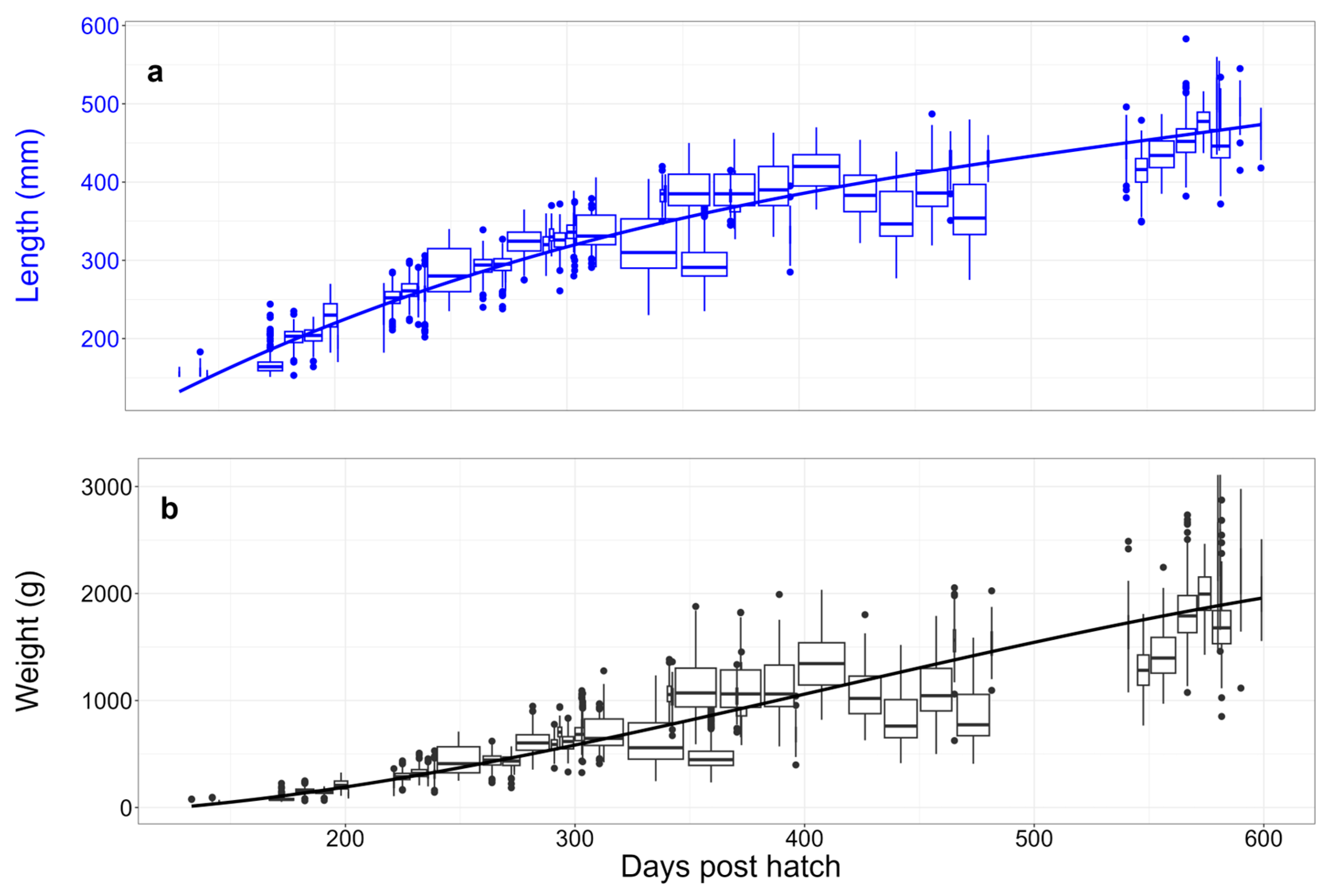

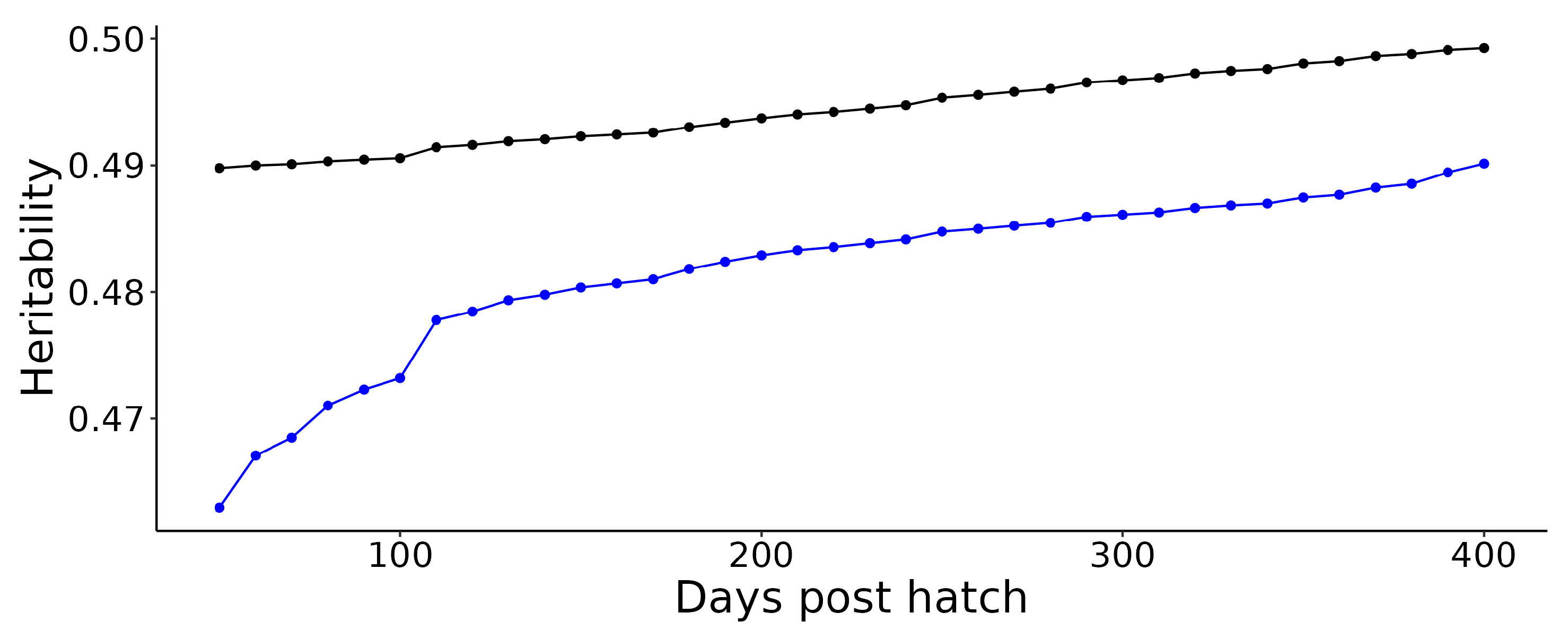
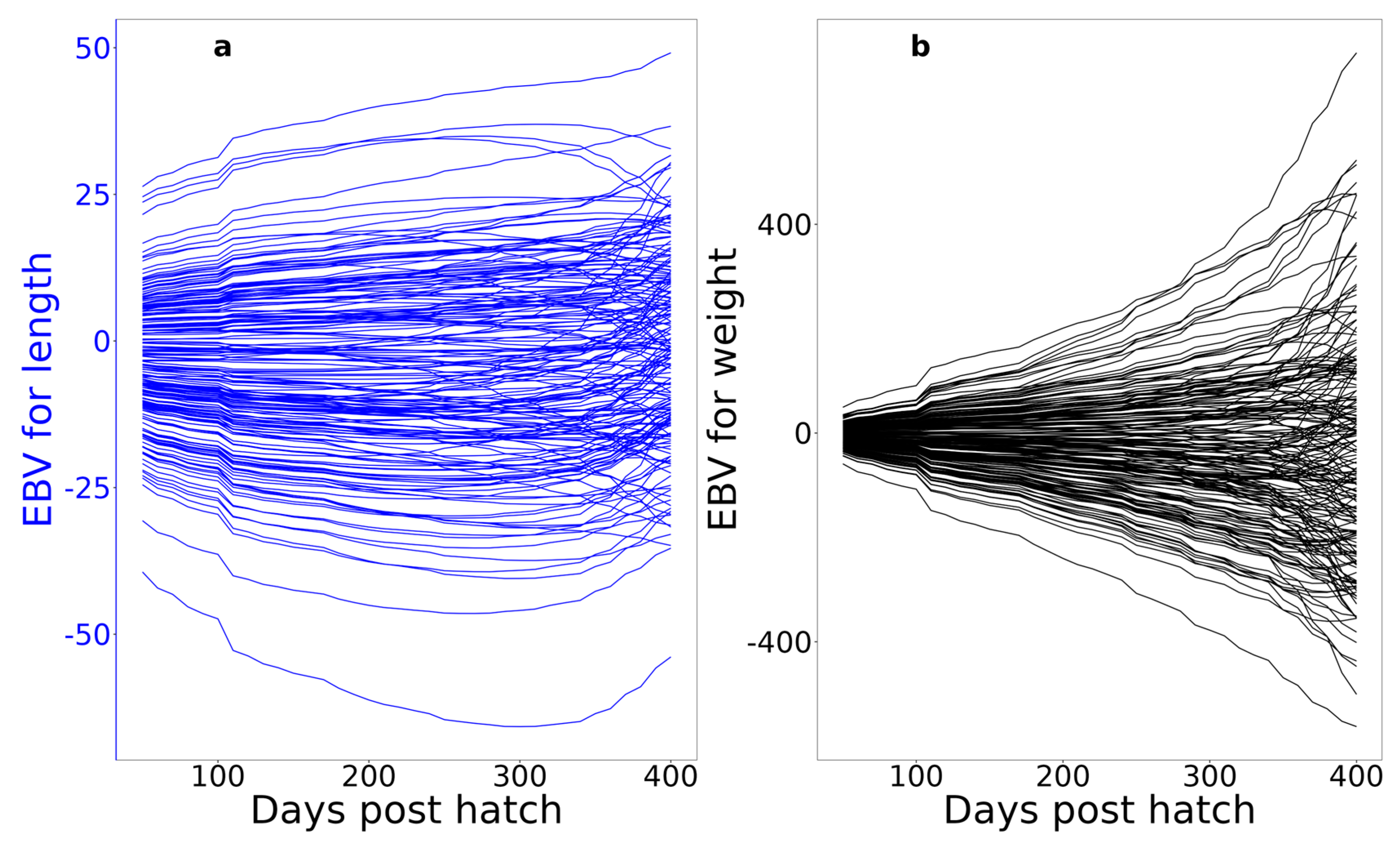
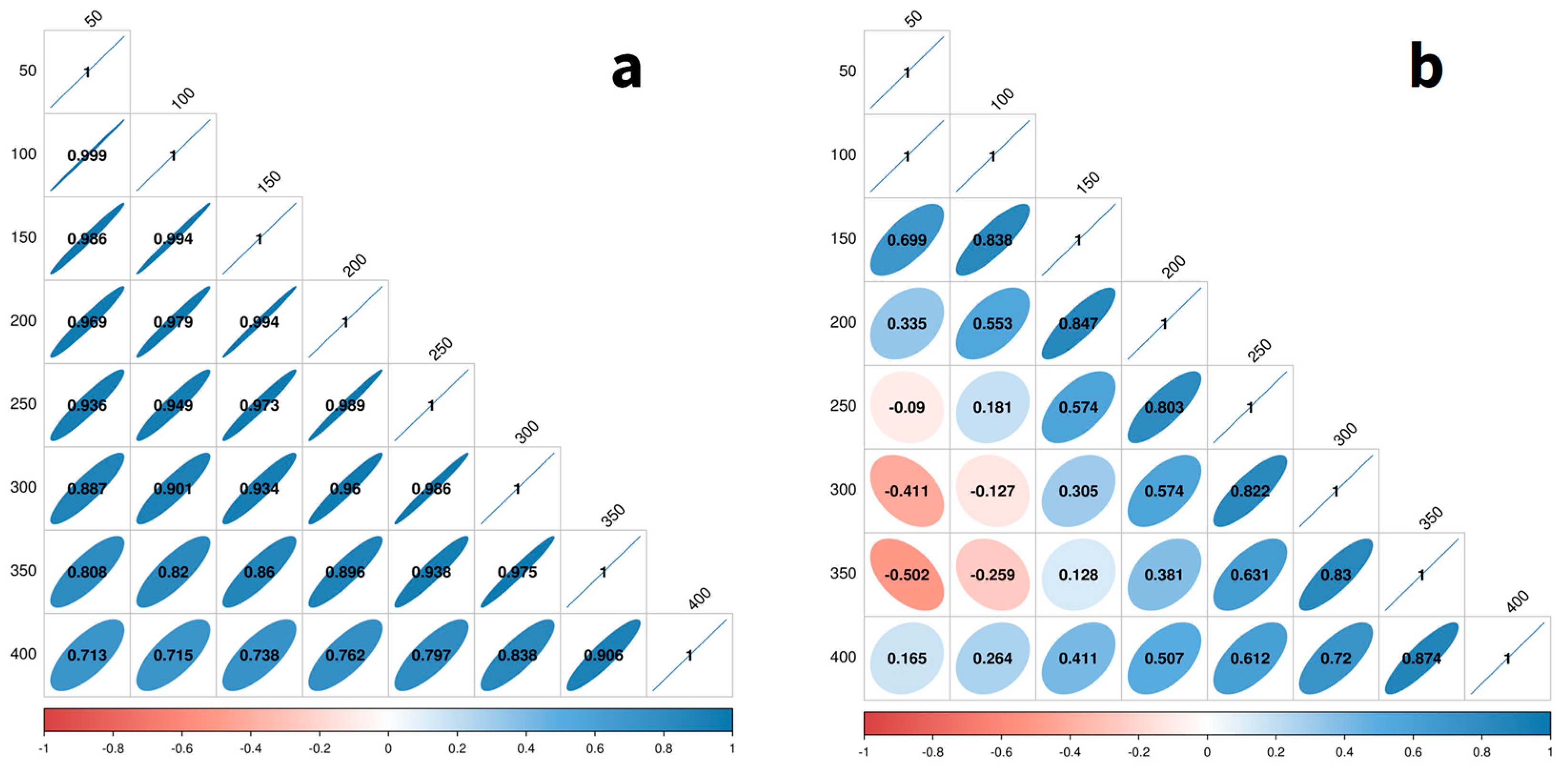
| Hatch Date | Sires | Dams | FS Families | Individuals |
|---|---|---|---|---|
| 2008-09-04 | 7 | 2 | 14 | 1020 |
| 2008-09-21 | 7 | 3 | 14 | 676 |
| 2008-10-02 | 4 | 1 | 4 | 95 |
| 2008-10-22 | 5 | 3 | 8 | 125 |
| 2008-11-02 | 7 | 7 | 27 | 3908 |
| 2010-09-25 | 4 | 1 | 4 | 628 |
| 2010-09-26 | 5 | 3 | 11 | 1516 |
| 2010-10-06 | 6 | 7 | 20 | 1680 |
| 2010-10-14 | 5 | 6 | 18 | 598 |
| 2010-11-11 | 8 | 6 | 31 | 2346 |
| 2010-12-01 | 8 | 6 | 30 | 1639 |
| 2013-09-18 | 7 | 6 | 19 | 1672 |
| 2013-09-21 | 5 | 5 | 16 | 323 |
| 2013-09-26 | 1 | 1 | 1 | 6 |
| 2013-11-19 | 2 | 1 | 2 | 237 |
| 2013-11-28 | 5 | 1 | 5 | 264 |
| Totals | 27 | 20 | 108 | 5252 |
| Model # | Degree of Fixed Leg | Degree of Genetic Leg | Degree of Family Leg | Degree of US PE Leg | Degree of DIAG PE Leg |
|---|---|---|---|---|---|
| 1 | 0 | 0 | - | - | - |
| 2 | 1 | 1 | - | - | - |
| 3 | 2 | 2 | - | - | - |
| 4 | 3 | 3 | - | - | - |
| 5 | 0 | 0 | 0 | - | - |
| 6 | 1 | 1 | 1 | - | - |
| 7 | 2 | 2 | 2 | - | - |
| 8 | 3 | 3 | 3 | - | - |
| 9 | 0 | 0 | 0 | - | - |
| 10 | 1 | 1 | 1 | - | - |
| 11 | 2 | 2 | 2 | - | - |
| 12 | 3 | 3 | 3 | - | - |
| 13 | 0 | 0 | 0 | - | - |
| 14 | 1 | 1 | 1 | - | - |
| 15 | 2 | 2 | 2 | - | - |
| 16 | 3 | 3 | 3 | - | - |
| 17 | 0 | 0 | - | 0 | - |
| 18 | 1 | 1 | - | 1 | - |
| 19 | 2 | 2 | - | 2 | - |
| 20 | 3 | 3 | - | 3 | - |
| 21 | 0 | 0 | - | - | 0 |
| 22 | 1 | 1 | - | - | 1 |
| 23 | 2 | 2 | - | - | 2 |
| 24 | 3 | 3 | - | - | 3 |
| A. Length | ||||
| Component | Univariate Estimate (SE) | AV% | Bivariate Estimate (SE) | AV% |
| Vg(L0) | 589.102 (14.436) | 83.1% | 570.796 (13.938) | 80.6% |
| Vg(L1) | 99.761 (4.702) | 14.1% | 89.843 (4.302) | 12.7% |
| Vg(L2) | 40.571 (2.381) | 5.7% | 36.161 (2.18) | 5.1% |
| Vg(L3) | 15.598 (1.322) | 2.2% | 11.7 (1.154) | 1.7% |
| Vr | 17.316 (0.325) | - | 19.683 (0.361) | - |
| Rg(L1,0) | 0.57 (0.019) | - | 0.603 (0.018) | - |
| Rg(L2,0) | −0.217 (0.03) | - | −0.249 (0.031) | - |
| Rg(L2,1) | 0.425 (0.027) | - | 0.45 (0.027) | - |
| Rg(L3,0) | 0.243 (0.033) | - | 0.233 (0.037) | - |
| Rg(L3,1) | 0.05 (0.044) | - | 0.147 (0.047) | - |
| Rg(L3,2) | 0.506 (0.036) | - | 0.503 (0.04) | - |
| B. Weight | ||||
| Component | Univariate Estimate (SE) | AV% | Bivariate Estimate (SE) | AV% |
| Vg(L0) | 50,451.476 (1339.018) | 0.565 | 48,818.61 (1284.097) | 0.547 |
| Vg(L1) | 33,364.535 (1091.894) | 0.374 | 31,747.182 (1033.043) | 0.356 |
| Vg(L2) | 8010.154 (333.67) | 0.09 | 7615.405 (314.228) | 0.085 |
| Vg(L3) | 1176.908 (65.241) | 0.013 | 1088.831 (61.122) | 0.012 |
| Vr | 233.312 (4.767) | - | 268.081 (5.335) | - |
| Rg(L1,0) | 0.926 (0.003) | - | 0.928 (0.003) | - |
| Rg(L2,0) | 0.378 (0.02) | - | 0.366 (0.02) | - |
| Rg(L2,1) | 0.691 (0.012) | - | 0.681 (0.012) | - |
| Rg(L3,0) | 0.115 (0.027) | - | 0.094 (0.028) | - |
| Rg(L3,1) | 0.368 (0.025) | - | 0.37 (0.025) | - |
| Rg(L3,2) | 0.814 (0.011) | - | 0.834 (0.011) | - |
| A. Length | ||||||||||||
| Model # | Degree of Fixed Leg | Degree of Genetic Leg | Degree of Family Leg | Degree of US PE Leg | Degree of DIAG PE Leg | DF for Fixed Effects | DF for Variance Components | Constrained Boundary Effects | Nearly Boundary Effects | Full Model AIC | Full Model BIC | loglik |
| 1 | 0 | 0 | - | - | - | 79 | 2 | - | - | 93,902.74 | 94,528.47 | −46,870.37 |
| 2 | 1 | 1 | - | - | - | 80 | 4 | - | - | 89,498.55 | 90,147.46 | −44,665.27 |
| 3 | 2 | 2 | - | - | - | 81 | 7 | - | - | 87,589.86 | 88,269.67 | −43,706.93 |
| 4 | 3 | 3 | - | - | - | 82 | 11 | - | - | 87,044.04 | 87,762.48 | −43,429.02 |
| 5 | 0 | 0 | 0 | - | - | 79 | 3 | - | - | 93,854.33 | 94,487.79 | −46,845.17 |
| 6 | 1 | 1 | 1 | - | - | 80 | 7 | - | - | 89,458.45 | 90,130.54 | −44,642.22 |
| 7 | 2 | 2 | 2 | - | - | 81 | 13 | - | - | 87,541.21 | 88,267.38 | −43,676.61 |
| 8 | 3 | 3 | 3 | - | - | 82 | 21 | - | 20 | 86,986.52 | 87,782.21 | −43,390.26 |
| 9 | 0 | 0 | 0 | - | - | 79 | 3 | 1 | - | 93,854.33 | 94,487.80 | −46,845.17 |
| 10 | 1 | 1 | 1 | - | - | 80 | 8 | 1 | - | 89,460.03 | 90,139.84 | −44,642.02 |
| 11 | 2 | 2 | 2 | - | - | 81 | 14 | 3 | 6 | 87,542.32 | 88,276.21 | −43,676.16 |
| 12 | 3 | 3 | 3 | - | - | 82 | 22 | 2 | 20 | 86,986.22 | 87,789.63 | −43,389.11 |
| 13 | 0 | 0 | 0 | - | - | 79 | 3 | 1 | - | 93,854.33 | 94,487.80 | −46,845.17 |
| 14 | 1 | 1 | 1 | - | - | 80 | 10 | - | 3 | 89,451.59 | 90,146.85 | −44,635.79 |
| 15 | 2 | 2 | 2 | - | - | 81 | 19 | - | 5 | 87,528.49 | 88,301.01 | −43,664.25 |
| 16 | 3 | 3 | 3 | - | - | 82 | 31 | - | 30 | 87,033.82 | 87,906.76 | −43,403.91 |
| 17 | 0 | 0 | - | 0 | - | 79 | 3 | - | - | 93,892.96 | 94,526.43 | −46,864.48 |
| 18 | 1 | 1 | - | 1 | - | 80 | 7 | - | 3 | 89,484.60 | 90,156.68 | −44,655.30 |
| 19 | 2 | 2 | - | 2 | - | 81 | 13 | - | 6 | 87,574.32 | 88,300.49 | −43,693.16 |
| 20 | 3 | 3 | - | 3 | - | 82 | 21 | - | 10 | 86,995.70 | 87,791.39 | −43,394.85 |
| 21 | 0 | 0 | - | - | 0 | 79 | 3 | - | - | 93,892.96 | 94,526.43 | −46,864.48 |
| 22 | 1 | 1 | - | - | 1 | 80 | 5 | 1 | - | 89,491.82 | 90,148.46 | −44,660.91 |
| 23 | 2 | 2 | - | - | 2 | 81 | 8 | 2 | - | 87,589.51 | 88,277.04 | −43,705.75 |
| 24 | 3 | 3 | - | - | 3 | 82 | 11 | 4 | - | 87,044.03 | 87,762.47 | −43,429.02 |
| B. Weight | ||||||||||||
| Model # | Degree of Fixed Leg | Degree of Genetic Leg | Degree of Family Leg | Degree of US PE Leg | Degree of DIAG PE Leg | DF for Fixed Effects | DF for Variance Components | Constrained Boundary Effects | Nearly Boundary Effects | Full Model AIC | Full Model BIC | loglik |
| 1 | 0 | 0 | - | - | - | 79 | 2 | - | - | 167,669.07 | 168,294.80 | −83,753.53 |
| 2 | 1 | 1 | - | - | - | 80 | 4 | - | - | 151,932.96 | 152,581.88 | −75,882.48 |
| 3 | 2 | 2 | - | - | - | 81 | 7 | - | - | 142,313.28 | 142,993.09 | −71,068.64 |
| 4 | 3 | 3 | - | - | - | 82 | 11 | - | - | 140,589.00 | 141,307.44 | −70,201.50 |
| 5 | 0 | 0 | 0 | - | - | 79 | 3 | - | - | 167,576.64 | 168,210.10 | −83,706.32 |
| 6 | 1 | 1 | 1 | - | - | 80 | 7 | - | - | 151,867.45 | 152,539.54 | −75,846.73 |
| 7 | 2 | 2 | 2 | - | - | 81 | 13 | - | 6 | 142,276.59 | 143,002.75 | −71,044.29 |
| 8 | 3 | 3 | 3 | - | - | 82 | 11 | 10 | - | 141,635.83 | 142,354.27 | −70,724.92 |
| 9 | 0 | 0 | 0 | - | - | 79 | 3 | 1 | - | 167,576.64 | 168,210.10 | −83,706.32 |
| 10 | 1 | 1 | 1 | - | - | 80 | 7 | 2 | - | 151,867.46 | 152,539.54 | −75,846.73 |
| 11 | 2 | 2 | 2 | - | - | 81 | 13 | 2 | - | 142,276.69 | 143,002.85 | −71,044.34 |
| 12 | 3 | 3 | 3 | - | - | 69 | 11 | 14 | - | 141,366.51 | 141,984.46 | −70,603.26 |
| 13 | 0 | 0 | 0 | - | - | 79 | 3 | 1 | - | 167,576.64 | 168,210.10 | −83,706.32 |
| 14 | 1 | 1 | 1 | - | - | 80 | 10 | - | 3 | 151,869.24 | 152,564.50 | −75,844.62 |
| 15 | 2 | 2 | 2 | - | - | 81 | 19 | - | 12 | 142,277.00 | 143,049.52 | −71,038.50 |
| 16 | 3 | 3 | 3 | - | - | 82 | 21 | 20 | 10 | 140,610.18 | 141,405.87 | −70,202.09 |
| 17 | 0 | 0 | - | 0 | - | 79 | 3 | 6 | - | 167,670.91 | 168,304.37 | −83,753.46 |
| 18 | 1 | 1 | - | 1 | - | 80 | 7 | - | 3 | 151,922.12 | 152,594.20 | −75,874.06 |
| 19 | 2 | 2 | - | 2 | - | 81 | 13 | - | 6 | 142,308.60 | 143,034.76 | −71,060.30 |
| 20 | 3 | 3 | - | 3 | - | 82 | 21 | - | 10 | 140,557.07 | 141,352.76 | −70,175.54 |
| 21 | 0 | 0 | - | - | 0 | 79 | 3 | - | - | 167,670.91 | 168,304.37 | −83,753.46 |
| 22 | 1 | 1 | - | - | 1 | 80 | 4 | 2 | - | 151,932.96 | 152,581.88 | −75,882.48 |
| 23 | 2 | 2 | - | - | 2 | 81 | 7 | 3 | - | 142,313.28 | 142,993.09 | −71,068.64 |
| 24 | 3 | 3 | - | - | 3 | 82 | 11 | 4 | - | 140,589.01 | 141,307.45 | −70,201.50 |
Disclaimer/Publisher’s Note: The statements, opinions and data contained in all publications are solely those of the individual author(s) and contributor(s) and not of MDPI and/or the editor(s). MDPI and/or the editor(s) disclaim responsibility for any injury to people or property resulting from any ideas, methods, instructions or products referred to in the content. |
© 2024 by the authors. Licensee MDPI, Basel, Switzerland. This article is an open access article distributed under the terms and conditions of the Creative Commons Attribution (CC BY) license (https://creativecommons.org/licenses/by/4.0/).
Share and Cite
Camara, M.D.; Symonds, J.E.; Walker, S.P.; McQueen, D.; Gublin, Y.; Irvine, G.; Pether, S.M.; Forsythe, A.; Setiawan, A.N. Genetic Parameter Estimates for Growth of Hāpuku (Groper, Polyprion oxygeneios) in Land-Based Aquaculture Using Random Regression Models. Fishes 2024, 9, 376. https://doi.org/10.3390/fishes9100376
Camara MD, Symonds JE, Walker SP, McQueen D, Gublin Y, Irvine G, Pether SM, Forsythe A, Setiawan AN. Genetic Parameter Estimates for Growth of Hāpuku (Groper, Polyprion oxygeneios) in Land-Based Aquaculture Using Random Regression Models. Fishes. 2024; 9(10):376. https://doi.org/10.3390/fishes9100376
Chicago/Turabian StyleCamara, Mark D., Jane E. Symonds, Seumas P. Walker, Dave McQueen, Yann Gublin, Glen Irvine, Steve M. Pether, Andrew Forsythe, and Alvin N. Setiawan. 2024. "Genetic Parameter Estimates for Growth of Hāpuku (Groper, Polyprion oxygeneios) in Land-Based Aquaculture Using Random Regression Models" Fishes 9, no. 10: 376. https://doi.org/10.3390/fishes9100376






